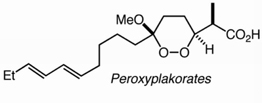Department of Chemistry
Date of this Version
2011
Citation
J Am Chem Soc. 2011 February 2; 133(4): 643–645.
Abstract
HSAF was isolated from Lysobacter enzymogenes, a bacterium used in the biological control of fungal diseases of plants. Structurally, it is a tetramic acid-containing macrolactam fused to a tricyclic system. HSAF exhibits a novel mode of action by disrupting sphingolipids important to the polarized growth of filamentous fungi. Here, we described the HSAF biosynthetic gene cluster which contains only a single-module polyketide synthase-nonribosomal peptide synthetase (PKS/ NRPS), although the biosynthesis of HSAF apparently requires two separate polyketide chains that are linked together by one amino acid (ornithine) via two amide bonds. Flanking the PKS/ NRPS are six genes, encoding a cascade of four tightly clustered redox enzymes on one side and a sterol desaturase/fatty acid hydroxylase and a ferredoxin reductase on the other side. The genetic data demonstrate that the four redox genes, in addition to the PKS/NRPS gene and the sterol desaturase/fatty acid hydroxylase gene, are required for HSAF production. The biochemical data show that the adenylation domain of the NRPS specifically activated L-ornithine and the fourdomain NRPS was able to catalyze the formation of a tetramic acid-containing product from acyl- S-ACP and ornithinyl-S-NRPS. These results reveal a previously unrecognized biosynthetic mechanism for hybrid PK/NRP in prokaryotic organisms.


Comments
Copyright © 2010 American Chemical Society